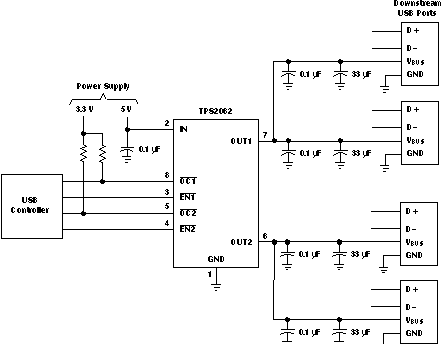ZHCSRR9J december 2003 – august 2023 TPS2061 , TPS2062 , TPS2063 , TPS2065 , TPS2066 , TPS2067
PRODMIX
- 1
- 1 特性
- 2 应用
- 3 说明
- 4 Revision History
- 5 说明(续)
- 6 Pin Configuration and Functions
- 7 Specifications
- 8 Parameter Measurement Information
- 9 Detailed Description
-
10Application and Implementation
- 10.1
Application Information
- 10.1.1 Power-supply Considerations
- 10.1.2 OC Response
- 10.1.3 Power Dissipation and Junction Temperature
- 10.1.4 Thermal Protection
- 10.1.5 Undervoltage Lockout (UVLO)
- 10.1.6 Universal Serial Bus (USB) Applications
- 10.1.7 Host/Self-Powered and Bus-powered Hubs
- 10.1.8 Low-power Bus-powered and High-Power Bus-Powered Functions
- 10.1.9 USB Power-distribution Requirements
- 10.1.10 Generic Hot-Plug Applications
- 10.1
Application Information
- 11Device and Documentation Support
- 12Mechanical, Packaging, and Orderable Information
10.1.7 Host/Self-Powered and Bus-powered Hubs
Hosts and SPHs have a local power supply that powers the embedded functions and the downstream ports (see Figure 10-3). This power supply must provide from 5.25 V to 4.75 V to the board side of the downstream connection under full-load and no-load conditions. Hosts and SPHs are required to have current-limit protection and must report overcurrent conditions to the USB controller. Typical SPHs are desktop PCs, monitors, printers, and stand-alone hubs.
 Figure 10-3 Typical Four-Port USB Host / Self-Powered Hub
Figure 10-3 Typical Four-Port USB Host / Self-Powered HubBPHs obtain all power from upstream ports and often contain an embedded function. The hubs are required to power up with less than one unit load. The BPH usually has one embedded function, and power is always available to the controller of the hub. If the embedded function and hub require more than 100 mA on power up, the power to the embedded function may need to be kept off until enumeration is completed. This can be accomplished by removing power or by shutting off the clock to the embedded function. Power switching the embedded function is not necessary if the aggregate power draw for the function and controller is less than one unit load. The total current drawn by the bus-powered device is the sum of the current to the controller, the embedded function, and the downstream ports, and it is limited to 500 mA from an upstream port.